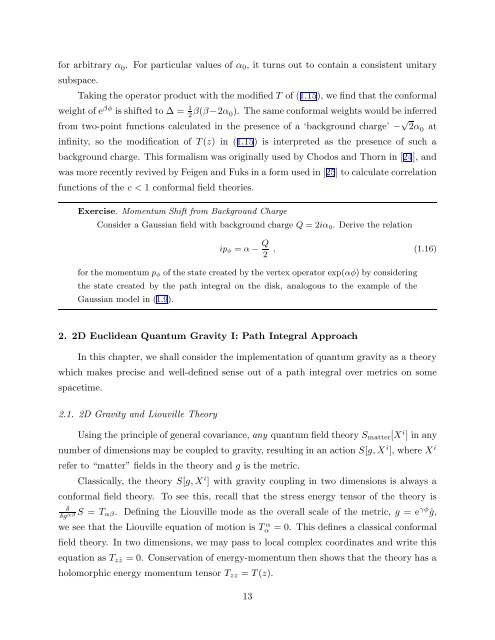arXiv:hep-th/9304011 v1 Apr 5 1993
arXiv:hep-th/9304011 v1 Apr 5 1993
arXiv:hep-th/9304011 v1 Apr 5 1993
Create successful ePaper yourself
Turn your PDF publications into a flip-book with our unique Google optimized e-Paper software.
for arbitrary α 0 . For particular values of α 0 , it turns out to contain a consistent unitary<br />
subspace.<br />
Taking <strong>th</strong>e operator product wi<strong>th</strong> <strong>th</strong>e modified T of (1.15), we find <strong>th</strong>at <strong>th</strong>e conformal<br />
weight of e βφ is shifted to ∆ = 1 2 β(β−2α 0). The same conformal weights would be inferred<br />
from two-point functions calculated in <strong>th</strong>e presence of a ‘background charge’ − √ 2α 0 at<br />
infinity, so <strong>th</strong>e modification of T (z) in (1.15) is interpreted as <strong>th</strong>e presence of such a<br />
background charge. This formalism was originally used by Chodos and Thorn in [24], and<br />
was more recently revived by Feigen and Fuks in a form used in [25] to calculate correlation<br />
functions of <strong>th</strong>e c < 1 conformal field <strong>th</strong>eories.<br />
Exercise. Momentum Shift from Background Charge<br />
Consider a Gaussian field wi<strong>th</strong> background charge Q = 2iα 0 . Derive <strong>th</strong>e relation<br />
ip φ = α − Q 2 , (1.16)<br />
for <strong>th</strong>e momentum p φ of <strong>th</strong>e state created by <strong>th</strong>e vertex operator exp(αφ) by considering<br />
<strong>th</strong>e state created by <strong>th</strong>e pa<strong>th</strong> integral on <strong>th</strong>e disk, analogous to <strong>th</strong>e example of <strong>th</strong>e<br />
Gaussian model in (1.9).<br />
2. 2D Euclidean Quantum Gravity I: Pa<strong>th</strong> Integral Approach<br />
In <strong>th</strong>is chapter, we shall consider <strong>th</strong>e implementation of quantum gravity as a <strong>th</strong>eory<br />
which makes precise and well-defined sense out of a pa<strong>th</strong> integral over metrics on some<br />
spacetime.<br />
2.1. 2D Gravity and Liouville Theory<br />
Using <strong>th</strong>e principle of general covariance, any quantum field <strong>th</strong>eory S matter [X i ] in any<br />
number of dimensions may be coupled to gravity, resulting in an action S[g, X i ], where X i<br />
refer to “matter” fields in <strong>th</strong>e <strong>th</strong>eory and g is <strong>th</strong>e metric.<br />
Classically, <strong>th</strong>e <strong>th</strong>eory S[g, X i ] wi<strong>th</strong> gravity coupling in two dimensions is always a<br />
conformal field <strong>th</strong>eory. To see <strong>th</strong>is, recall <strong>th</strong>at <strong>th</strong>e stress energy tensor of <strong>th</strong>e <strong>th</strong>eory is<br />
δ<br />
δg αβ S = T αβ . Defining <strong>th</strong>e Liouville mode as <strong>th</strong>e overall scale of <strong>th</strong>e metric, g = e γφ ĝ,<br />
we see <strong>th</strong>at <strong>th</strong>e Liouville equation of motion is T α α = 0. This defines a classical conformal<br />
field <strong>th</strong>eory. In two dimensions, we may pass to local complex coordinates and write <strong>th</strong>is<br />
equation as T z¯z = 0. Conservation of energy-momentum <strong>th</strong>en shows <strong>th</strong>at <strong>th</strong>e <strong>th</strong>eory has a<br />
holomorphic energy momentum tensor T zz = T (z).<br />
13
















